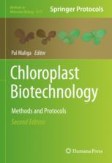Search
Search Results
-
Selectable Markers to Marker-Free Selection in Rice
Inadequate rice production worldwide is largely attributed to abiotic and biotic stresses, along with high sensitivity of cultivable plant germplasm....

-
Customizable and stable multilocus chromosomal integration: a novel glucose-dependent selection system in Aureobasidium spp.
BackgroundNon-conventional yeasts hold significant potential as biorefinery cell factories for microbial bioproduction. Currently, gene editing...

-
An Overview on Selection Marker Genes for Transformation of Saccharomyces cerevisiae
For genetic manipulation of yeast, numerous selection marker genes have been employed. These include prototrophic markers, markers conferring drug...
-
Marker-Free Transplastomic Plants by Excision of Plastid Marker Genes Using Directly Repeated DNA Sequences
Excision of marker genes using DNA direct repeats makes use of the efficient native homologous recombination pathway present in the plastids of algae...
-
Chloroplast transformation in new cultivars of tomato through particle bombardment
A protocol has been established for genetic transformation of the chloroplasts in two new cultivars of tomato ( Solanum lycopersicum L.) grown in...

-
Plastid Marker Gene Excision in the Tobacco Shoot Apex by Agrobacterium-Delivered Cre Recombinase
Here we describe a protocol for the excision of plastid marker genes directly in tobacco (Nicotiana tabacum) plants by the Cre recombinase. The...
-
Cis Genesis of Crops
The term cisgenesis has been defined as ‘the genetic modification of plants using genes that originate only from the species itself or from a species...
-
A Simple Technology for Generating Marker-Free Chloroplast Transformants of the Green Alga Chlamydomonas reinhardtii
The availability of routine methods for the genetic engineering of the chloroplast genome of Chlamydomonas reinhardtii is allowing researchers to...
-
Use of the ptxD gene as a portable selectable marker for chloroplast transformation in Chlamydomonas reinhardtii
Synthetic biology and genetic engineering in algae offer an unprecedented opportunity to develop species with traits that can help solve the problems...

-
Towards green biomanufacturing of high-value recombinant proteins using promising cell factory: Chlamydomonas reinhardtii chloroplast
Microalgae are cosmopolitan organisms in nature with short life cycles, playing a tremendous role in reducing the pressure of industrial carbon...

-
Deep orange gene editing triggers temperature-sensitive lethal phenotypes in Ceratitis capitata
BackgroundThe Mediterranean fruit fly, Ceratitis capitata , is a significant agricultural pest managed through area-wide integrated pest management...

-
Engineering Camelina sativa Seeds as a Green Bioreactor for the Production of Affordable Human Pro-insulin that Demonstrates Anti-diabetic Efficacy in Rats
The current production of recombinant insulin via fermenter-based platforms ( Escherichia coli and yeast) could not fulfill its fast-growing...

-
Genetic Engineering of Trichoderma reesei for Biomass Hydrolysis
The filamentous fungus Trichoderma reesei, a potent cellulase producer, is the most-studied cellulolytic fungus. This fungus is an efficient cell...
-
Bxb1-att Site-Specific Recombination System-Mediated Autoexcision to Prevent Environmental Transgene Escape
Transgenic plants are obtained experimentally with low frequency. Scientists use selectable marker genes (SMGs) and selection agents to select...
-
Expression of apple MdMYB10 transcription factor in sugar beet with a screenable marker role and antimicrobial activity
Selection of transgenic plants by using genes encoding screenable markers of plant origin with health benefit properties, such as anthocyanin is an...

-
Co-overexpression of chitinase and β-1,3-glucanase significantly enhanced the resistance of Iranian wheat cultivars to Fusarium
Fusarium head blight (FHB) is a devastating fungal disease affecting different cereals, particularly wheat, and poses a serious threat to global...

-
Identification of a Yarrowia lipolytica acetamidase and its use as a yeast genetic marker
BackgroundYarrowia lipolytica is an oleaginous yeast that can be genetically engineered to produce lipid and non-lipid biochemicals from a variety...

-
Recent Advances in Antibiotic-Free Markers; Novel Technologies to Enhance Safe Human Food Production in the World
Crops that have been genetically modified (GM) include additional beneficial traits that present fresh approaches to boosting yield productivity and...

-
Research Progress on Edible Fungi Genetic System
In order to obtain strains with targeted changes in genetic characteristics, molecular biology and genetic engineering techniques are used to...
-
Strategies for Strain Improvement of Economically Important Microorganisms
Microorganisms are sustainable assets for meeting the rising demand of growing industries. However, the wide uses of microbial-derived products are...
